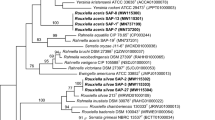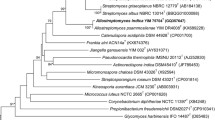Abstract
Based on DNA-fingerprinting, ITS-DNA sequencing and physiological characteristics, a new species of Schizonella, Sch. caricis-atratae, is described. Sch. caricis-atratae is a so-called cryptic species, i.e. morphologically it is identical to Sch. melanogramma, but differs in physiological and molecular phylogenetic characters. Sch. caricis-atratae can be distinguished by the following tests: growth on myo-inositol, D,L-lactate, salicine, maltose, αmethyl-D-glucoside, butane-2,3-diol, and D-turanose, at 30°C; no growth on galactose. Sch. caricis-atratae can be isolated from Carex atrata. The type strain is HB 3, CBS 123477.






Similar content being viewed by others
References
Bauer R, Lutz M, Begerow D, Piatek M, Vánky K, Bacigálová K, Oberwinkler F (2008) Anther smut fungi on monocots. Mycol Res 112:1297–1306. doi:10.1016/j.mycres.2008.06.002
Begerow D, Stoll M, Bauer R (2006) A phylogenetic hypothesis of Ustilaginomycotina based on multiple gene analyses and morphological data. Mycologia 98:906–916. doi:10.3852/mycologia.98.6.906
Denchev CM (1997) Anthracoideaceae, a new family in the Ustilaginales. Mycotaxon 65:411–417
Dörfler C (1990) Vergleichende Untersuchungen zum biochemischen Aufbau der Zellwand an Hefestadien von niederen und höheren Basidiomyceten. Bibl Mycol 129:1–164
Hong S-B, Go S-J, Shin H-D, Frisvad J, Samson RA (2005) Polyphasic taxonomy of Aspergillus fumigatus and related species. Mycologia 97:1316–1329. doi:10.3852/mycologia.97.6.1316
Kimura M (1980) A simple model for estimating evolutionary rates of base substitutions through comparative studies of nucleotide sequences. J Mol Evol 16:111–120. doi:10.1007/BF01731581
Lopandic K, Prillinger H, Molnár O, Giménez-Jurado G (1996) Molecular characterization and genotypic identification of Metschnikowia species. Syst Appl Microbiol 19:393–402
Messner R, Prillinger H, Altmann F, Lopandic K, Wimmer K, Molnár O, Weigang F (1994) Molecular characterization and application of random amplified polymorphic DNA analysis of Mrakia and Sterigmatomyces species. Int J Syst Bacteriol 44:694–703
Nakase T, Suzuki M (1986) Bullera megalospora, a new species of yeast forming large ballistospores isolated from dead leaves of Oryza sativa, Miscanthus sinensis and Sasa sp. in Japan. J Gen Appl Microbiol 32:225–240. doi:10.2323/jgam.32.225
Prillinger H, Dörfler C, Laaser G, Hauska G (1990) Ein Beitrag zur Systematik und Entwicklungsbiologie Höherer Pilze: Hefe-Typen der Basidiomyceten Teil III: Ustilgago-Typ. Z Mykol 56:251–278
Prillinger H, Lopandic K, Schweigkofler W, Deak R, Aarts HJM, Bauer R, Sterflinger K, Kraus GF, Maraz A (2002) Phylogeny and Systematics of the Fungi with Special Reference to the Ascomycota and Basidiomycota. In Breitenbach M, Crameri R, Lehrer S (eds) Fungal Allergy and Pathogenicity. Chem Immun Vol. 81, pp 207–294. Karger, Basel
Prillinger H, Lopandic K, Sugita T, Wuczkowski M (2007) Asterotremella gen. nov. albida, an anamorphic tremelloid yeast isolated from the agarics Asterophora lycoperdoides and Asterophora parasitica. J Gen Appl Microbiol 53:167–175. doi:10.2323/jgam.53.167
Thompson JD, Gibson TJ, Plewniak F, Jeanmougin F, Higgins DG (1997) The ClustalX windows interface: flexible strategies for multiple sequence alignments aided by quality analysis tools. Nucleic Acids Res 1:79–86
Van de Peer Y, De Wachter R (1994) TREECON for windows: a software package for the construction and drawing of evolutionary trees for the Microsoft Windows environment. Comput Appl Biosci 10:569–570
Vánky K (1985) Carpathian Ustilaginales. Acta Univ Upsaliensis Symbolae Botanicae Upsalienses XXIV(2):1–309
Vánky K (1994) European Smut Fungi. Gustav Fischer, Stuttgart
Vánky K (1998) Taxonomical studies on Ustilaginales XVIII. Mycotaxon 69:93–115
Wuczkowski M, Druzhinina I, Gherbawy Y, Klug B, Prillinger H, Kubicek CP (2003) Species pattern and genetic diversity of Trichoderma in a mid-European, primeval floodplain-forest. Microbiol Res 158:125–133. doi:10.1078/0944-5013-00193
Wuczkowski M, Metzger E, Sterflinger K, Prillinger H (2005) Diversity of yeasts isolated from litter and soil of different natural forest sites in Austria. Bodenkultur 56:201–208
Yarrow D (1998) Methods for the isolation, maintenance and identification of yeasts. In: Kurtzman CP, Fell JW (eds) The yeasts, a taxonomic study. 4th edn. Elsevier, Amsterdam, pp 854–872
Acknowledgements
We thank Dr. K. Vánky for critical reading the manuscript. We gratefully acknowledge the help of Dr. M. Weiss in preparing the Latin diagnoses.
Author information
Authors and Affiliations
Corresponding author
Rights and permissions
About this article
Cite this article
Prillinger, H., Wuczkowski, M., Lopandic, K. et al. Schizonella caricis-atratae (Ustilaginomycetes): a new cryptic species on Carex atrata from Austria. Mycol Progress 8, 157–164 (2009). https://doi.org/10.1007/s11557-009-0588-2
Received:
Revised:
Accepted:
Published:
Issue Date:
DOI: https://doi.org/10.1007/s11557-009-0588-2




